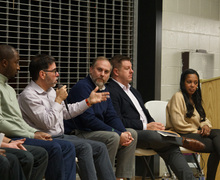Fewer graduates in 2010 report holding full-time jobs
The job market proved more challenging for Syracuse University’s Class of 2010 than for the previous year’s graduates, reflecting the continued effects of the country’s economic downturn.
‘I believe the Class of 2010 represents probably the worst job market for college graduates in the last 15 years,’ said Michael Cahill, director of SU Career Services.
SU’s Class of 2010 Placement Report will be published on Career Services’ website by the end of the week, Cahill said. The annual report details employment and salary of students within six months of graduation.
For 2010, many SU graduates were able to obtain jobs through internships, and some vied for graduate school instead of job searching. The market is expected to turn around for 2011 college graduates as employers begin to increase their job postings.
Only 60 percent of respondents from the Class of 2010 reported holding full-time positions within six months of graduation, a decrease from 2009 when 65 percent of respondents reported full-time employment, according to the report. In reports from the previous five years — from 2004 to 2008 — between 74 and 79 percent of graduates reported obtaining a full-time job within six months of graduation.
Most of the 2010 information for the annual report was collected using a survey emailed to graduates in October. Nearly 37 percent, or 956 graduates, of the 2,585 bachelor’s degree recipients in 2010 responded to the survey. Cahill said the responses received this year allow for a good snapshot of the class.
Although full-time employment among graduates was down in 2010, the average salaries of graduates increased. There were also more respondents employed in New York state than in 2009.
The average salary for 2010 graduates was $43,000, an increase from $40,932 in 2009. Graduates of the School of Information Studies had the highest average salary at $55,800, and the L.C. Smith College of Engineering and Computer Science was second at $54,500.
The College of Human Ecology, which had only nine graduates who provided salary information, had the lowest average salary at $30,200. The College of Visual and Performing Arts and the S.I. Newhouse School of Public Communications had the second- and third-lowest salaries. VPA’s graduates had an average salary of $32,200 and Newhouse graduates had an average salary of $32,600.
But students’ educational background is going to play into whether or not they are hired, as well as their salary, Cahill said.
‘A lot of it really is a matter of supply and demand,’ Cahill said. ‘We still don’t educate enough engineers to fit the needs of the world, and that’s the same in technology areas, so they’re going to be able to command a little bit higher salary. For most communication companies, all you have to do is open your door and say we have jobs here and you’re going to have a line.’
Eighty-seven percent of the respondents who found a position within six months of graduating reported their job was related to their career goals, a decrease of 3 percent from last year.
‘I think we’re finding that students are taking positions just to bridge into the opportunity that they really want to have,’ Cahill said.
For 2010, 54 percent of respondents holding a full-time job are working in New York state, compared to 52 percent in 2009. Of those working in New York, 14 percent reported being employed in Central New York, an increase from 12 percent in 2009.
In the job market, graduates often take a job that isn’t their first or second choice, something not as frequent in previous years, Cahill said. Job searching now requires more persistence and work from the student, he said.
‘You kind of have to prepare yourself for it to take a little bit longer, whether it means taking a part-time job or going back to something you did in the summer just to sustain yourself,’ he said.
Many students are going to graduate school because of the tough market, Cahill said.
In the 2010 report, 21 percent of respondents reported they’re continuing their studies in graduate school, which is the same percentage as 2009. Forty-one percent of those in graduate school are enrolled at SU, compared to 30 percent in 2009.
The overall placement rate, which includes those holding a full-time position and those attending graduate school, is 81 percent for the Class of 2010, a drop from 2009 when the placement rate was 86 percent. The placement rate had reached 94 percent in 2008 and 95 percent in 2006 and 2007.
‘We’ve seen the overall placement rate being about 95 percent,’ Cahill said. ‘The last few years, it’s been down and is a little bit lower this year. I think this is the bottom. I think we’re going to see it come up next year.’
Employers are planning to hire 19.3 percent more college graduates in 2010-11 than 2009-10, according to the National Association of Colleges and Employers Job Outlook 2011 Spring Update survey released in April. Employers have received nearly 45 percent more applications this year, but the total number of job postings reported by employers has nearly tripled, according to the survey. The survey included responses from 174 employers.
Cahill said one of the trends that have emerged during the past few placement reports is students obtaining their job from an internship. In the 2010 report, 20 percent of responding graduates reported obtaining their job through an internship, and 25 percent reported it in 2009.
‘It’s like a long interview,’ Cahill said. ‘By the end of a three-month period of time, you can pretty much tell if a student, if an intern, is going to fit in your organization and be able to contribute. It’s a good process, really, for both.’
Published on April 26, 2011 at 12:00 pm
Contact Jon: jdharr04@syr.edu





